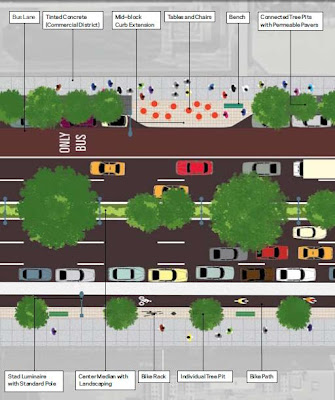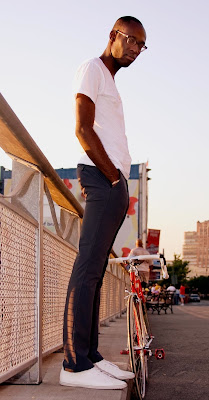
Friday, December 11, 2009
Empowerment 2.0

Thursday, December 10, 2009
New York Street Design
 Earlier this year, New York City’s Department of Transportation released their Street Design Manual, with the purpose of being a guide towards quality design and sound implementation. After defining street typologies, the document continues to outline how people interact with the space, the materials used, and aesthetics, specifically lighting and furniture considerations.
Earlier this year, New York City’s Department of Transportation released their Street Design Manual, with the purpose of being a guide towards quality design and sound implementation. After defining street typologies, the document continues to outline how people interact with the space, the materials used, and aesthetics, specifically lighting and furniture considerations. The manual’s overall goals are:
These ideas are expanded upon here.

These guides are fun reads as they look towards innovations and successes from cities all around the world, attempting to apply international ideas to their respective city. After all, a good design can work anywhere.
The Street Design Manual can be found via New York City’s DOT.
Wednesday, December 9, 2009
Google SketchUp Pro 7
Tuesday, December 8, 2009
Wonderwall Inc.
 Fred Perry Moscow by Wonderwall
Fred Perry Moscow by WonderwallI had to post this.

Frank O. Gehry "since 1997" Exhibition
 Walt Disney Concert Hall, 1999 -2003 @ 1:50 scale
Walt Disney Concert Hall, 1999 -2003 @ 1:50 scaleThe future of pedestrian navigation
Better late than never, Utah
This story brings me back to my half-completed thesis project as it takes a look at the built environment and how it affects citizens’ health.
There are healthy lifestyle movements happening in cities all over the world, but no coordinated effort to plan healthy, walkable communities. We are required to take time out of our day to drive to a gym to run in a single place - there is something not very practical with that picture. If a healthy development plan was inherent, this would change the way people interact with cities, benefiting us in the long term, also promoting a more sustainable lifestyle - prompting us to walking to school, to amenities or even having live/work arrangements.
The following illustrates a place starting from the basics, with several neighbourhoods even lacking sidewalks. Poor design and weak policies are promoting sedentary lifestyles keeping neighbourhoods unhealthy and contributing to the rising Body Mass Index (BMI) levels.

These ideas are explored through Utah, but think of your neighbourhood when reading this, especially if you’re the type to drive everywhere.
Via The Salt Lake TribuneFriday, December 4, 2009
Best in Shoe* The Work Boot

Wednesday, December 2, 2009
Art:21: Place
 Richard Serra's Torqued Ellipse VI" (1999)
Richard Serra's Torqued Ellipse VI" (1999)"Artists explore the idea of place by questioning commonly held assumptions about land, home and national identity."
Friday, November 20, 2009
Climate Change Adaptation
- economic resources
- availablitiy of and access to technology
- information
- skills
- degree of prepardness of infrastructure and institutions


Saturday, November 14, 2009
Vancouverism
 Living Shangri-La is Vancouver's tallest building. Designed by James KM Cheng Architects Inc. (Photo by Uncle Buddha via Flickr)
Living Shangri-La is Vancouver's tallest building. Designed by James KM Cheng Architects Inc. (Photo by Uncle Buddha via Flickr)Wednesday, November 11, 2009
Hosang Park's 'A Square'

From Seoul, South Korea, Hosang Park's photographic series A Square articulates how public spaces blend in with urban living environments.
Friday, November 6, 2009
Blueprint America: Road to the Future
 Featuring Denver, Portland and New York
Featuring Denver, Portland and New YorkThis episode of PBS' documentary series Blueprint America examines the United States' investment in its aging infrastructure and changes that are happening now by looking at several American cities and the systems they have created.
Toronto wins 2015 Pan Am Games


The Games will surely be good for tourism and potential public transit advances but will it cost us money or make us money?
Wednesday, November 4, 2009
PublicART: Eagles in the City
 (Photo by LK Cavers)
(Photo by LK Cavers)When visiting Vancouver a few months back, it was hard not to notice the 7½ foot bald eagles taking over public spaces every several intersections (and in places you would least expect).
- To create an event that provides maximum exposure to sponsoring organizations, artists and the recipient charity
- To invite tourists from around the world to visit our province and share in our culture
- To produce an event that encourages the 'Arts', local businesses and individuals to come together in a spirit of community fundraising, benefiting the important work of the BC Lions Society's Easter Seal Services.
- To generate artistic creativity and showcase BC artists
- To celebrate the cultural diversity of our province and promote civic pride
- To capture the imagination of children, adults, and tourists alike
- To raise much needed funds to provide Easter Seal Services to children with disabilities
Ontario's Top 20 Worst Roads

Driving down Steeles Avenue east from my girlfriend's place reminded me to post this link from CAA's website released last week. The list of the Province's worst roads include eight in found in Toronto alone, topped by my route home today.
Toronto is planning a $10 million resurfacing of Steeles Avenue pending the approval of Federal infrastructure stimulus funding. A hefty $139 million of Toronto's annual budget goes towards road repairs, but they have been suffering from a $300 million roadwork backlog.
This is what it costs to make Toronto's roads drivable (courtesy of The Star):
- $25 Average cost to repair one pothole
- 275,000 Potholes fixed by the city in 2008
- $6 million Cost of pothole repairs annually in Toronto
- $7,000-$10,000 Annual cost of preventative patching, routing and sealing 1 km of new four-lane road
- $110,000 Cost of applying new overlay to the same stretch (year 15, or earlier if the preventative work has been neglected)
- $650,000 Cost of full reconstruction of road (year 20 if neglected; year 40 otherwise)
Broadband Infrastructure: A Primer

Urbanspoon App

It's amazing how often this App comes in handy - and can lead to fun and exciting new discoveries in food!
Saturday, October 31, 2009
City Fabric: Outlier
 "Tailored performance clothing for cycling in the city"
"Tailored performance clothing for cycling in the city"Campus Walk: York University
The Ross Building is an example of what 1960s and 70s architecture looked like and has been criticized as looking like slabs of concrete piled on top of each other. It has a charm to it, doesn't it? Walking around campus, you will notice the several different architectural styles it employs based on the era the particular building was built.
Markham's Sustainability Fair
McGill University's Dr. Avi Friedman (also one of *Wallpaper Magazine's 10 people “most likely to change the way we live”) spoke on sustainability and what can be done in Markham to enhance the Town's connectivity and contribute to the health of the residents. His theme - and what has been the theme of the week - is that collectively, we have lost our way. Friedmann got nostalgic and stressed the need to revert back to the old ways of living where markets would come to the people, living in bi-generational neighbouhoods, and town squares built for neighbours to congregate all contribute to our social network.
This inspiring speech was what Markham needed to get started on creating a sustainability plan. Small group activities followed, allowing for Town staff and residents to collaborate and voice their concerns in a constructive manner on various topics (such as water conservation, social equity and so on). This was the first of several meetings to develop the Green Print so stay tuned!
Friday, October 30, 2009
Making Sense of Place




